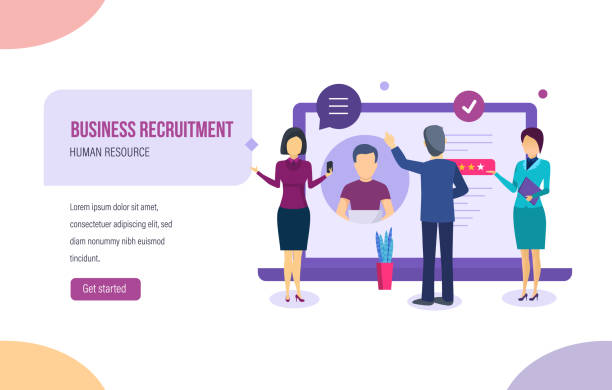Understanding the Principles of Modern User Interface Website Design

#Web_Design, #User_Interface, and #User_Experience are the three main pillars of any successful website in today’s world.
In the digital age, where competition for user attention has peaked, merely having a website is not enough; your website must provide a unique and memorable experience.
This is where the concept of modern user interface website design comes in.
A modern user interface goes beyond mere aesthetics; this approach means creating an interactive environment where users can easily connect with it, access the information they need, and complete their tasks without any confusion.
This concept includes principles and methods that help you design a user-friendly, fast, and visually appealing website.
User Interface (UI) refers to the visual and interactive components of a website; from buttons and menus to forms and fonts.
But User Experience (UX) takes a more comprehensive view and addresses the overall feeling of the user when using your product; was it easy to use? Did it meet the user’s needs? Was it enjoyable? Modern UI web design is, in fact, an intelligent fusion of these two areas, aiming to create an efficient, beautiful, and deeply satisfying digital ecosystem for the end-user.
In this process, attention to details such as page load time, compatibility with various devices (responsiveness), and providing clear and understandable content is of particular importance.
Are you dissatisfied with the low sales of your online store?
Rasaweb is your solution for having a professional and high-selling online store.
✅ Significant increase in sales and revenue
✅ Easy and enjoyable shopping experience for customers
⚡ Get free consultation from Rasaweb now!
Key Elements in Creating an Unparalleled User Experience
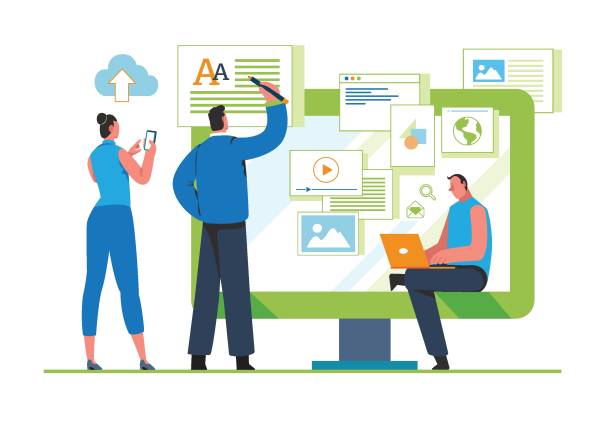
#UX, #UI, and #User_Centricity are inseparable concepts in creating superior digital experiences.
To successfully implement modern user interface website design, one must focus on several key elements.
The first and most important principle is user-centricity; meaning all design decisions must be based on user needs, behaviors, and expectations.
This includes a thorough understanding of user personas and their usage scenarios.
Second, simplicity and minimalism; cluttered and complex user interfaces confuse users and divert them from their main goal.
Minimalism in design means removing unnecessary elements and focusing on the main content.
Third, adaptability and responsiveness; your website must display correctly on all devices, from desktops to mobiles and tablets, and provide a consistent user experience.
This is not only important for user satisfaction but also crucial for SEO.
Fourth, clarity and visual feedback; users should always know where they are, what they can do, and what the results of their actions will be.
Using subtle animations, meaningful colors, and clear messages can help with this.
Finally, speed and high performance; nothing frustrates a user as much as a slow website.
Optimizing images, using optimized code, and leveraging high-speed servers are among the actions that must be taken in this regard.
By adhering to these principles, you can build a website that is not only visually appealing but also highly efficient and enjoyable for users.
The Importance of User Research and Analysis in Modern Web Design
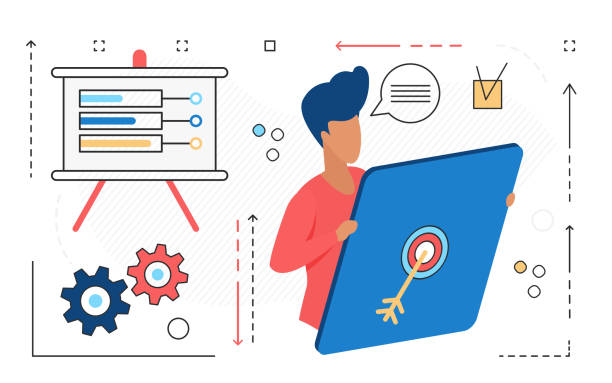
#User_Research, #Persona, and #Usability_Testing are the foundations of any modern UI web development.
Without a deep understanding of target users, website design will be mere guesswork.
User research involves collecting data about their needs, behaviors, motivations, and challenges.
This process can be carried out through various methods such as interviews, surveys, observation, and analysis of behavioral data (like heatmaps and session recordings).
The information obtained from these studies helps the design team create user ‘personas’.
Personas are fictional but data-driven characters that represent users’ demographic characteristics, goals, motivations, and pain points.
With clear personas, designers can make more informed decisions about layout, navigation, content, and even the tone of the website.
Usability Testing is another critical stage where a sample of real users interacts with the website’s prototype or beta version, and their feedback is collected to identify weaknesses and necessary improvements.
This continuous cycle of research, design, testing, and improvement ensures that the final website meets user needs in the best possible way.
The success of a website depends on user satisfaction, and this satisfaction will not be achieved without sufficient investment in user understanding.
To better understand the differences between User Interface and User Experience, refer to the table below.
| Feature | User Interface (UI) | User Experience (UX) |
|---|---|---|
| Definition | Visual appearance and interactivity of the product | Overall user feeling from interaction with the product |
| Main Focus | Aesthetics, layout, color scheme, fonts, buttons | Ease of use, efficiency, enjoyment, accessibility |
| Goal | Creating an attractive and visual user interface | Solving user problems, creating a satisfying experience |
| Key Questions | Does it look beautiful? Is it easy to use? | Does it meet user needs? Does it have a clear path to achieve the goal? |
| Examples | Designing icons, choosing colors, designing forms | User research, user testing, user journey mapping |
Leading Tools and Technologies in Modern UI Design

#Design_Tools, #Frameworks, and #CSS_Frameworks are the backbone of any modern UI website creation.
The world of web design is rapidly changing, and new tools are constantly being introduced to simplify the design and development process.
For web designers and developers looking to create unparalleled user experiences, familiarity with these tools is essential.
In the design sector, software like Figma, Sketch, and Adobe XD are recognized as industry standards.
These tools enable UI design, rapid prototyping, and team collaboration.
Figma has gained particular popularity due to its real-time collaboration capabilities and browser-based accessibility.
For web development, front-end frameworks like React, Vue.js, and Angular allow developers to build dynamic and interactive user interfaces.
These frameworks accelerate the development process and simplify code maintenance by utilizing reusable components.
Also, CSS frameworks like Tailwind CSS and Bootstrap are powerful tools for responsive design and rapidly creating website aesthetics.
Tailwind CSS, with its “utility-first” approach, provides full control over styles, while Bootstrap, by offering pre-designed components, is suitable for quickly starting projects.
The choice of the right tool depends on project needs and team preferences, but using up-to-date and efficient tools can significantly improve the quality and speed of website UI design and development.
Are you losing business opportunities due to an outdated website? With Rasaweb, permanently solve the problem of not attracting potential customers through your website!
✅ Attract more high-quality leads
✅ Increase brand credibility in the eyes of customers
⚡ Get free corporate website design consultation now!
Visual and Creative Trends in Today’s Website Design

#Minimal_Design, #Dark_Mode, and #Micro_Interactions are among the most important visual trends in modern UI website design that have revolutionized user visual experience.
In recent years, we have witnessed significant changes in website aesthetics.
One of the most prominent trends is the inclination towards minimal design and Whitespace.
This approach, by focusing on simplicity, removing superfluous elements, and creating visual breathing room, helps users concentrate on the main content and avoids visual clutter.
Color gradients and 3D images have also made a comeback, adding depth and appeal to websites.
Dark Mode has also become a popular feature that is not only useful for reducing eye strain in low-light environments but also gives websites a stylish and modern appearance.
Micro-interactions – small, subtle animations that appear when clicking buttons, filling out forms, or displaying success messages – also play a significant role in improving user experience and creating a sense of dynamism on the site.
These animations, though small, can create a stronger emotional connection with the user.
Creative typography and the use of custom fonts also give websites a unique visual identity.
Furthermore, Floating Design, where visual elements are designed to appear as if they are moving or floating in space, adds a sense of depth and dynamism to the user interface.
These trends indicate that the visual design of websites is not limited to aesthetics but increasingly moves towards creating more interactive and richer experiences to engage users further.
Optimizing Site Performance for a Smooth User Experience
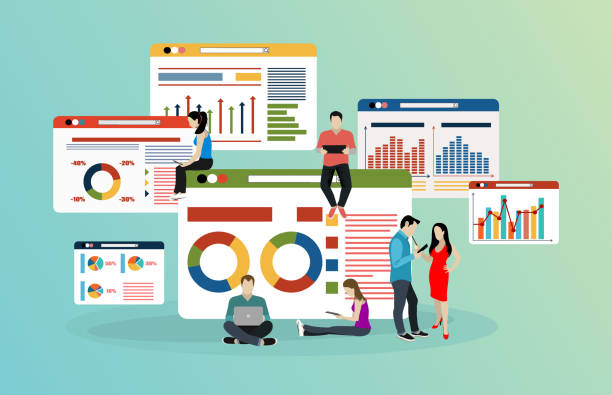
#Site_Optimization, #Load_Speed, and #Compression are crucial factors for the success of any modern UI website design.
No matter how beautiful and user-friendly a user interface is, if its load speed is low, it will lose users.
Today’s users expect high speed and instant responsiveness from websites.
Studies have shown that even a one-second delay in page loading can lead to a significant decrease in conversion rates. To achieve optimal performance, there are several fundamental strategies.
First, image optimization; large image files are among the most common reasons for slow site speed.
Using appropriate image formats (like WebP), compressing images without losing quality, and employing lazy loading can dramatically increase load speed.
Second, code optimization; compressing CSS, JavaScript, and HTML files (Minification and Gzip Compression), removing redundant and unnecessary code, and improving code structure help reduce file sizes and increase processing speed.
Third, using a CDN (Content Delivery Network); CDNs deliver your website’s content from the closest server to the user by distributing it across various servers worldwide, which reduces latency and increases load speed.
Fourth, choosing suitable and powerful hosting.
A high-quality host with sufficient resources plays a vital role in website speed and stability.
Finally, enabling Browser Caching allows the user’s browser to store static website files, eliminating the need for re-downloading on subsequent visits.
These measures not only improve user experience but also significantly contribute to website SEO.
Inclusivity and Accessibility in Modern Website Design
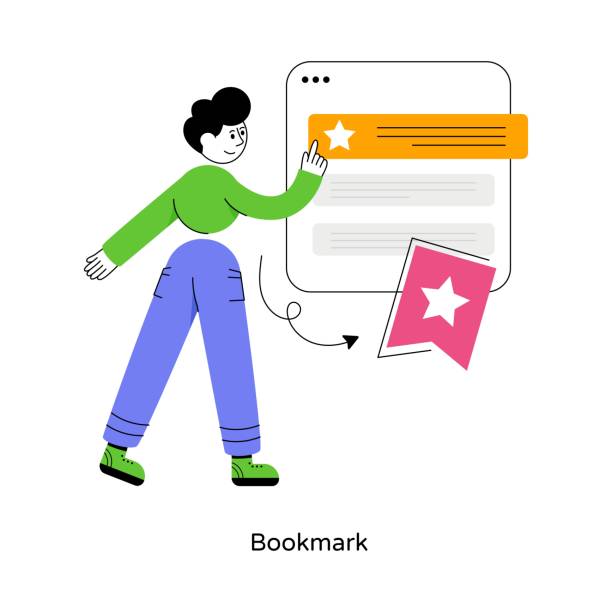
#Accessibility, #WCAG, and #Inclusive_Design are fundamental principles in modern UI website design that are often overlooked but are crucial for creating a truly global web.
Accessibility means that your website should be usable by all individuals, including those with disabilities (such as visual, auditory, motor, or cognitive impairments).
Ignoring this aspect is not only ethically wrong but can also lead to losing a large portion of the audience and even have legal consequences in some countries.
The Web Content Accessibility Guidelines (WCAG) published by the World Wide Web Consortium (W3C) are the best guide for designers and developers.
Adhering to WCAG includes providing alternative text (alt text) for images, using sufficient color contrast for text and background, keyboard navigation for all interactive elements, providing captions for audio and video content, logical and semantic structure for web pages, and using simple and understandable language.
Inclusive Design goes beyond mere accessibility and means designing products that are built from the outset to meet a wide range of user needs and abilities, rather than merely being adapted for disabled individuals after completion.
This approach ensures that your website provides an efficient and enjoyable experience for all users, regardless of their individual abilities.
Below are key tips for improving web design accessibility.
| WCAG Principle | Description | Implementation Example |
|---|---|---|
| Perceivable | Content must be presented in a way that users can perceive it, even if they require different methods to understand information. | Using alternative text (Alt Text) for images, providing captions for videos, using appropriate color contrast. |
| Operable | User interface components and navigation must be operable. | Full keyboard navigation, no time limits for task completion, avoidance of seizure-inducing elements. |
| Understandable | Information and user interface operation must be understandable. | Using simple and clear language, designing consistent and predictable navigation, providing appropriate guidance and feedback. |
| Robust | Content must be robust enough to be interpreted by a wide range of assistive technologies. | Using standard and valid HTML coding, defining roles and ARIA attributes for complex elements. |
What Path Will the Future of User Interface and User Experience Design Take?

#Artificial_Intelligence, #Virtual_Reality, and #Voice_Interfaces are emerging and challenging trends that shape the future of modern UI website design.
With rapid technological advancements, the future of UI/UX is heading towards making our interactions with digital devices more natural, personalized, and immersive.
One of the most important trends is the increasing role of Artificial Intelligence (AI) and Machine Learning (ML) in design.
AI can identify patterns by analyzing user behavioral data and automatically personalize user interfaces for each user.
This will mean highly customized and predictive user experiences that meet user needs even before they realize them.
Virtual Reality (VR) and Augmented Reality (AR) also offer new opportunities for designing 3D and immersive user interfaces.
Imagine a website where you can view products in an augmented reality environment or walk through a virtual store.
These technologies can elevate user interactions to an entirely new level, blurring the lines between the physical and digital worlds.
Voice User Interfaces (VUI) like voice assistants (e.g., Siri and Alexa) are also growing, creating a need for designs based on natural conversations and without the need for a screen.
This means focusing on tone, conversational flow, and intelligent responses.
Furthermore, Haptics, or tactile feedback, can add a sense of physical interaction to digital interfaces, enriching the experience.
Should future designers think about sensors and multi-sensory interactions instead of screens? The future of UI/UX is moving towards creating seamless, intelligent, and fully personalized experiences where interactions with technology will resemble natural conversations with a human.
Does your current website convert visitors into customers, or does it drive them away? Solve this problem permanently with professional corporate website design by Rasaweb!
✅ Build strong credibility and branding
✅ Attract target customers and increase sales
⚡ Get a free consultation now!
Case Study: Modern UI Website Design – Successful Examples

#Case_Study, #Successful_Website, and #Design_Portfolio can inspire many who are looking to develop websites with a modern user interface.
Examining successful examples can help in better understanding how to implement UI/UX principles in the real world.
One prominent example is music streaming platform websites like Spotify.
Spotify’s UI design heavily focuses on simplicity, personalization, and intuitive navigation.
This platform, using AI algorithms, offers music suggestions based on user taste, providing a highly personalized listening experience.
Its clean UI, utilizing dark mode and attractive visual elements, allows the user to focus on content without distraction.
Another example is accommodation booking websites and applications like Airbnb.
Airbnb’s design is an excellent example of user-centricity.
The process of searching, filtering, and booking accommodation is designed to be very smooth and frictionless.
The use of high-quality images, interactive maps, and user reviews helps increase trust and transparency.
Its navigation system is simple and understandable, allowing users to easily go from the search phase to final booking.
Also, news websites and online magazines like The New York Times are examples of advanced UI website design that provide an enjoyable reading experience with flexible layouts (grid systems), legible typography, and intelligent use of whitespace.
These sites also effectively utilize responsiveness to adapt to various screen sizes.
These examples demonstrate that a successful UI/UX design is a combination of aesthetics, performance, and a deep understanding of user needs, leading to positive and satisfying interactions.
Challenges and Solutions for Achieving Modern Website Design

#Design_Challenges, #Best_Practices, and #Site_Maintenance are among the important topics encountered on the path to modern UI website design.
Although the benefits of modern web design are numerous, achieving it is not without challenges.
One of the biggest challenges is keeping pace with changing technology trends and user expectations.
The digital world is evolving rapidly, and what is considered modern today may become obsolete tomorrow.
The solution to this challenge is continuous investment in the training and skill development of the design and development team, as well as constant monitoring of user feedback and analysis of performance data.
Another challenge is the balance between aesthetics and performance.
Sometimes, designers may focus so much on visual aspects that they neglect site performance and speed.
The solution to this problem is a multidisciplinary team approach where UI/UX designers and front-end developers collaborate closely from the outset to ensure both aspects (aesthetics and efficiency) are covered.
Ensuring accessibility for all users is also a significant challenge that requires special attention to WCAG standards and guidelines from the very early stages of design.
Furthermore, maintaining a modern and up-to-date website is a continuous challenge in itself.
Content must be kept fresh, site security ensured, and bugs promptly fixed.
Regular maintenance strategies, security updates, and periodic testing are vital for the long-term stability and success of a modern UI website.
By understanding these challenges and implementing appropriate solutions, one can achieve a website design that is not only visually stunning but also functionally flawless and provides a lasting experience for users.
Frequently Asked Questions
| No. | Question | Answer |
|---|---|---|
| 1 | What does modern user interface mean in website design? | It means designing a website that has a beautiful, attractive, and up-to-date appearance, while being easy, intuitive, and enjoyable for the user to use (emphasis on UX/UI). |
| 2 | What are the main features of a modern user interface? | Includes minimal design, sufficient whitespace usage, attractive typography, a harmonious color palette, high-quality images and icons, full responsiveness, high loading speed, and appropriate use of animations and micro-interactions. |
| 3 | Why is having a modern user interface important for a website? | It improves user experience, increases visitor trust, reduces bounce rate, increases user time on site, strengthens the brand, and ultimately helps achieve business goals (such as sales or user acquisition). |
| 4 | What is the role of Responsive Design in modern user interface? | Responsiveness is a crucial component; a website with a modern user interface must display correctly and perform optimally on all devices (mobile, tablet, desktop). |
| 5 | How does typography (font selection) affect modern user interface? | Appropriate typography increases readability, defines information hierarchy, and plays a significant role in creating a modern visual aesthetic consistent with brand identity. |
| 6 | What is the importance of using Whitespace in modern design? | Whitespace allows visual elements to “breathe,” prevents clutter, enhances user focus on the main content, and creates a clean, professional appearance. |
| 7 | What role do Micro-interactions play in improving modern user interface? | Micro-interactions (such as button color changes on click, form submission confirmation messages) provide visual feedback to the user, make site usage more interactive and enjoyable, and convey a sense of attention to detail. |
| 8 | What tools are used for modern user interface design? | Common tools include Figma, Sketch, Adobe XD, and even Prototyping Tools. |
| 9 | How can one ensure that a modern user interface is also usable? | Through User Testing, receiving feedback from real users, adhering to Accessibility principles, and Intuitive Navigation. |
| 10 | Does modern design mean removing all graphic elements? | No, being modern means intelligent and purposeful use of graphic elements, colors, images, and animations to create an attractive yet functional experience, not their unnecessary removal. |
And other advertising services of Rasaweb advertising agency
The role of response speed in the success of website ads
How to use sponsored ads on commercial websites
Placing ads on websites with hairdressing forums
Advertising strategies for inexpensive hairdressing equipment
The role of regular ad updates in attracting customers
And over hundreds of other services in the field of internet advertising, advertising consultation, and organizational solutions
Internet Advertising | Advertising Strategy | Advertorial
🚀 With Rasaweb Afarin, your business takes flight in the digital world! We offer innovative and results-driven solutions for your growth with comprehensive services including responsive website design, SEO, and content marketing.
📍 Tehran, Mirdamad Street, next to Bank Markazi, Kazerun Jonubi Alley, Ramin Alley, No. 6

